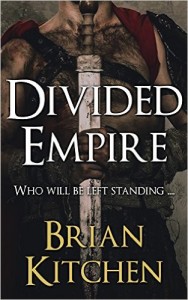Brian Kitchen talks about Divided Empire
I first became fascinated with the Roman period of British history when I was a child and read the ‘Eagle of the Ninth’ trilogy of novels by Rosemary Sutcliff. When I grew older I studied the period, reading as much as I could about it and also visiting as many sites and museums with collections of Roman artefacts as I was able to. My passion for writing had started at an early age too and fortunately wasn’t deterred when one of my English teachers criticised a composition I’d written saying it showed too much imagination!
The inspiration for ‘Divided Empire’ came back in 1994 when I came across an article in our local newspaper, the Burton Mail, written by a local historian, Dennis Bladon, who theorised that Burton upon Trent where I live, was the lost Roman settlement of Ad Trivonam. At the time Dennis’ theory wasn’t given much credence, but four years later, a Roman road was discovered leading from Leicester in the direction of Burton, which helped to support it. One interpretation of the name Ad Trivonam is ‘the meeting of three roads, by the river’. Well, Burton already had the routes of two Roman roads running through it and this new road was the third. Also Burton is built by the banks of the River Trent. Ad Trivonam as Burton became more of a reality and by coincidence I met Dennis two years ago, at the local hospital that we both volunteer at. I got to know him and told him that Ad Trivonam would be the home of the main character in the novel I was writing.
Further inspiration for ‘Divided Empire’ came from our local castle at Tutbury, near Burton upon Trent. Although the castle is Norman, it is built within the site of an Iron Age Hill Fort, as is the village itself. When the well in the castle was being cleaned out some years ago, a number of small Roman artefacts were found, including a pair of tweezers and some Samian pottery shards. Also when I visited the castle some years ago, I saw displayed in the tea room at the castle, two stone carvings. Whether they are still there now I don’t know, but mean to find out. One of the stone carvings fascinated me, as it looked very much like stone carvings that I’d seen of the Celtic God Cernunnos. The other stone carvings looked like a Celtic fertility goddess, but obviously I’m not an expert. I learnt however that they had been found in the River Dove, which runs through the valley below the rocky hill the castle stands on, which explained the worn condition of the carvings.
Not far from both Burton upon Trent and Tutbury is the village of Abbots Bromley, where each usually each September, the Horn Dance takes place. Although the present Horn Dance dates from the Middle Ages, there is some belief it has its roots in pagan times. The Celtic tribe which occupied the West Midlands was the Cornovii and it is possible that their boundaries stretched as far as Burton & Tutbury. The meaning of the tribes’ name has long been a matter of conjecture, but Anne Ross thought that the tribes name contained the element meaning ‘horn’ (cornu) and could therefore possibly mean the tribe were worshippers of a horned deity. Cernunnos is one such horned deity and in ‘Divided Empire’ it is the one the Cornovii worship. For my novel the boundaries of the Cornovii in the east stretch as far as the River Dove and Ad Trivonam and Tutbury, which is known as the ‘Lookout fort on the Dufan’ are both within the tribes territory.
Please visit my website for further information on me & the places in Divided Empire & the Flavius Vitulasius series;
Divided Empire is published by Endeavour Press

